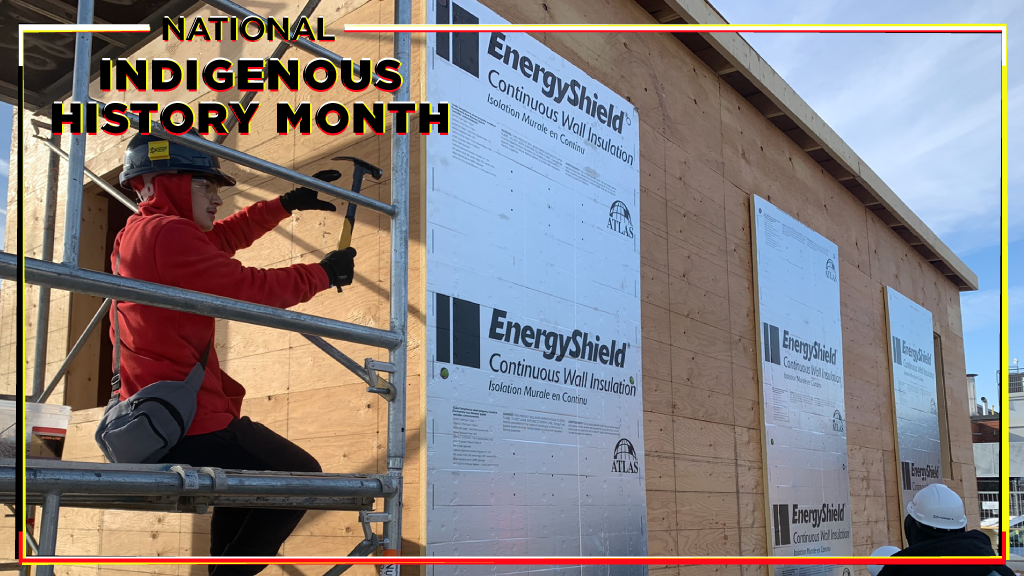Students in the skilled trades program at two Peel District School Board schools are getting a unique opportunity to build tiny homes for a big cause.
In partnership with Habitat for Humanity Halton-Mississauga, Judith Nyman and Brampton Centennial Secondary School students in Brampton, Ont. are building tiny homes as part of their project for the Specialist High Skills Major (SHSM) program. The homes are expected to be sent to the Chippewas of Nawash Unceded First Nation, Bruce Peninsula community.
Frank Meleca, curricular head of tech/SHSM program and lead teacher, and Joe Yoon, tech construction teacher, started the program at Judith Nyman last year.
“Habitat approached us and asked us if we were willing to be part of this build,” Meleca recalled. “We were approached given that we have 17 trade shops in our school. We were well equipped to run the project. We had about 44 kids working on it when we started the first build and it was our first time ever.”
The Peel District School Board is a big supporter of the trades, he added.
“As everyone knows there is a high demand for skilled trades,” Meleca noted. “Given we are one of the largest tech schools in the Peel District School Board, they thought we would be a great fit.”
Getting students engaged in building
While Meleca and Yoon have a background in renovations and the trades, teaching students how to build a tiny home was not an easy task.
“It was quite a struggle, I’m not going to lie, because this was the first time we’d ever done something like this,” Meleca admitted. “Once we got going it was great. There was a lot of teamwork.”
They started with the basics: looking at the drawings.
“It was really interesting to have students who have never had that thought process,” Meleca said. “They see things built but they don’t actually understand how they get there.”
Then they stenciled the blueprints.
“What we’ve done in one of the shops is we’ve done the layout on the floor so the students were able to take the blueprint and then actually visually see what a wall would look like, what a roof would look like and how to put things together in order for them to actually build this house,” said Meleca, adding the tiny home is being built on a portion of the school’s parking lot.
Students proud to give back
The students had a lot of questions around why they were building the house.
“Once we started explaining to them that the intent was that this home was going to go to an Indigenous community and someone was actually going to live in it, they became even more proud of building this home,” Meleca said.
Some students were more interested in aspects of the project than others.
“Some were stronger in framing, some were better at drywalling, some of them were better at the small little things,” said Meleca, adding about 20 per cent of the students who worked on the project were females.
“Most of our girls were better at the details, so measurements, reading the drawings and understanding where things would actually go in the home. Once we got our team together of students we would build every day, three periods a day, sometimes four periods a day. Some days we would stay after school. Some days we would get here early in the morning to try to get the build done.”
Meleca and Yoon became like foremen on a worksite.
“We had to make sure everyone was engaged yet making sure everyone stayed safe, everyone used the tools properly and at the same time still running a site,” he said. “We treated it as a site. You need to wear a hard hat, safety glasses, gloves. You need to have the proper gear on.”
Some of the SHSM students are trained to work at heights and were able to work on the top part of the home.
“They worked on scaffolding and during the roofing process,” said Meleca. “All we did is sheath the roof. They had roofers that came in but our students, the ones that had training at heights, were able to watch the steel roof go in. They learned something new. That opened their eyes to another trade that they may be interested in.”
Tiny home will benefit Indigenous community
The project is currently close to 80 per cent complete.
Although there was a shortage of materials, most of the exterior work is complete and the kitchen cabinets were recently installed.
Through conversations with Indigenous partners, a decision will be made on how the homes will be utilized.
The first tiny house the school built was used for temporary or emergency housing for community members battling with mental health and addiction.
Students, parents and the community have a sense of pride when it comes to the tiny home, Meleca said.
“A lot of these kids come from different walks of life,” he explained. “Some of them are in foster care, some of them don’t have homes. For them to actually want to build a home for someone else when they don’t even have their own home…they’re trying to do better for others.
“A lot of them have matured. They love this project. It’s something they are interested in doing and they want to continue doing it.”
Follow the author on Twitter @DCN_Angela.



Recent Comments